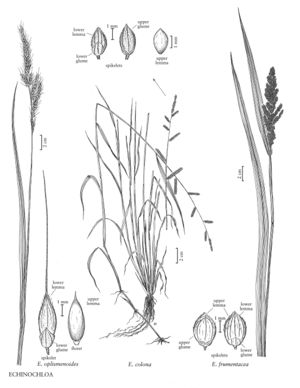Difference between revisions of "Echinochloa colona"
FNA>Volume Importer |
FNA>Volume Importer |
||
| Line 20: | Line 20: | ||
-->{{Treatment/Body | -->{{Treatment/Body | ||
|distribution=Mont.;Oreg.;Wash.;Pacific Islands (Hawaii);Fla.;N.J.;N.Mex.;Tex.;La.;Tenn.;N.C.;S.C.;Pa.;Va.;Calif.;Puerto Rico;Virgin Islands;Ala.;Ark.;Vt.;Ill.;Ga.;Mass.;Ariz.;Md.;Okla.;Mo.;Kans.;Miss.;Ky. | |distribution=Mont.;Oreg.;Wash.;Pacific Islands (Hawaii);Fla.;N.J.;N.Mex.;Tex.;La.;Tenn.;N.C.;S.C.;Pa.;Va.;Calif.;Puerto Rico;Virgin Islands;Ala.;Ark.;Vt.;Ill.;Ga.;Mass.;Ariz.;Md.;Okla.;Mo.;Kans.;Miss.;Ky. | ||
| − | |discussion=<p | + | |discussion=<p>Echinochloa colona is widespread in tropical and subtropical regions. It is adventive and weedy in North America, growing in low-lying, damp to wet, disturbed areas, including rice fields. The unbranched, rather widely-spaced panicle branches make this one of the easier species of Echinochloa to recognize.</p><!-- |
| − | --><p>Hitchcock (1913) considered that 'colonum' was a non-declining contraction, but dictionaries of Linnaeus' time treated it as a declining adjective. Because Linnaeus was the first to name the species (as " | + | --><p>Hitchcock (1913) considered that 'colonum' was a non-declining contraction, but dictionaries of Linnaeus' time treated it as a declining adjective. Because Linnaeus was the first to name the species (as "Panicum colonum"), it seems best to follow the practice considered correct in his day; hence "E. colona".</p> |
|tables= | |tables= | ||
|references= | |references= | ||
| Line 37: | Line 37: | ||
|basionyms= | |basionyms= | ||
|family=Poaceae | |family=Poaceae | ||
| + | |illustrator=Linda A. Vorobik and Hana Pazdírková | ||
|distribution=Mont.;Oreg.;Wash.;Pacific Islands (Hawaii);Fla.;N.J.;N.Mex.;Tex.;La.;Tenn.;N.C.;S.C.;Pa.;Va.;Calif.;Puerto Rico;Virgin Islands;Ala.;Ark.;Vt.;Ill.;Ga.;Mass.;Ariz.;Md.;Okla.;Mo.;Kans.;Miss.;Ky. | |distribution=Mont.;Oreg.;Wash.;Pacific Islands (Hawaii);Fla.;N.J.;N.Mex.;Tex.;La.;Tenn.;N.C.;S.C.;Pa.;Va.;Calif.;Puerto Rico;Virgin Islands;Ala.;Ark.;Vt.;Ill.;Ga.;Mass.;Ariz.;Md.;Okla.;Mo.;Kans.;Miss.;Ky. | ||
|reference=None | |reference=None | ||
| Line 42: | Line 43: | ||
|publication year= | |publication year= | ||
|special status= | |special status= | ||
| − | |source xml=https:// | + | |source xml=https://bibilujan@bitbucket.org/aafc-mbb/fna-data-curation.git/src/314eb390f968962f596ae85f506b4b3db8683b1b/coarse_grained_fna_xml/V25/V25_1118.xml |
|subfamily=Poaceae subfam. Panicoideae | |subfamily=Poaceae subfam. Panicoideae | ||
|tribe=Poaceae tribe Paniceae | |tribe=Poaceae tribe Paniceae | ||
Revision as of 17:13, 30 October 2019
Plants annual; erect or decumbent, cespitose or spreading, rooting from the lower cauline nodes. Culms 10-70 cm; lower nodes glabrous or hispid, hairs appressed; upper nodes glabrous. Sheaths glabrous; ligules absent, ligule region frequently brown-purple; blades 8-22 cm long, 3-6(10) mm wide, mostly glabrous, sometimes hispid, hairs papillose-based on or near the margins. Panicles 2-12 cm, erect, rachises glabrous or sparsely hispid; primary branches 5-10, 0.7-2(4) cm, erect to ascending, spikelike, somewhat distant, without secondary branches, axes glabrous or sparsely hispid, hairs 1.5-2.5 mm, papillose-based. Spikelets 2-3 mm, disarticulating at maturity, pubescent to hispid, hairs usually not papillose-based, tips acute to cuspidate. Lower glumes about 1/2 as long as the spikelets; upper glumes about as long as the spikelets; lower florets usually sterile, occasionally staminate; lower lemmas unawned, similar to the upper glumes; lower paleas subequal to the lemmas; upper lemmas 2.6-2.9 mm, not or scarcely exceeding the upper glumes, elliptic, coriaceous portion rounded distally, passing abruptly into a sharply differentiated, membranous, soon-withering tip; anthers 0.7-0.8 mm. Caryopses 1.2-1.6 mm, whitish; embryos 63-83% as long as the caryopses. 2n = 54.
Distribution
Mont., Oreg., Wash., Pacific Islands (Hawaii), Fla., N.J., N.Mex., Tex., La., Tenn., N.C., S.C., Pa., Va., Calif., Puerto Rico, Virgin Islands, Ala., Ark., Vt., Ill., Ga., Mass., Ariz., Md., Okla., Mo., Kans., Miss., Ky.
Discussion
Echinochloa colona is widespread in tropical and subtropical regions. It is adventive and weedy in North America, growing in low-lying, damp to wet, disturbed areas, including rice fields. The unbranched, rather widely-spaced panicle branches make this one of the easier species of Echinochloa to recognize.
Hitchcock (1913) considered that 'colonum' was a non-declining contraction, but dictionaries of Linnaeus' time treated it as a declining adjective. Because Linnaeus was the first to name the species (as "Panicum colonum"), it seems best to follow the practice considered correct in his day; hence "E. colona".
Selected References
None.
